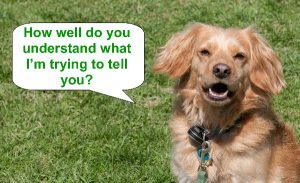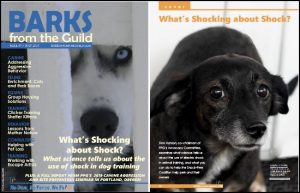< Updated 29NOV19 >
< A short link for this page – http://bit.ly/KnowledgeforPetParents >
Our pets do not come with a user manual, and their normal behavior can often be quite different from what we expect or desire. When we chose to live with another species, it is important to understand their normal behaviors as well as abnormal behaviors, if our relationship with them is going to be mutually beneficial.
In 2015, the American Animal Hospital Association (AAHA) issued their Canine and Feline Behavior Management Guidelines, which state: “More dogs and cats are affected by behavioral problems than any other condition, often resulting in euthanasia, relinquishment of the patient, or chronic suffering.” The report explains that a major reason for behavioral problems is erroneous information about pets and what constitutes normal versus abnormal behavior and appropriate training methods. Misinformation often comes from family, friends, neighbors, rescues/shelters, and even pet care professionals such as veterinarians and trainers. The following resources will provide you with current, and accurate information based on science, so you can better understand your cat or dog, and have a more harmonious relationship with them
Canine Behavior, Dog Training, and Dog to Human Communications
Articles & Blog Posts
Pet Health and Wellness – Your Pet’s Behavioral Health Is As Important As Their Physical Well-Being – A review of the American Animal Hospital  Association (AAHA) 2015 Canine and Feline Behavior Management Guidelines and the importance of attending to our pets emotional and behavioral well-being. – http://bit.ly/WWM_AAHA_Bhx
Association (AAHA) 2015 Canine and Feline Behavior Management Guidelines and the importance of attending to our pets emotional and behavioral well-being. – http://bit.ly/WWM_AAHA_Bhx
PODCAST – Pet Behavior, Vets & The AAHA Canine and Feline Behavior Management Guidelines with Dr. Dave Cloutier from Veazie Veterinary Clinic – In this podcast from The Woof Meow Show Kate, Don and Dr. Dave Cloutier of the Veazie Veterinary Clinic discuss  the American Animal Hospital Associations (AAHA) new guidelines on behavior management for dogs and cats. This groundbreaking document represents the first time that a major veterinary organization has addressed pet behavior. According to the guidelines, “More dogs and cats are affected by behavioral problems than any other condition, often resulting in euthanasia, relinquishment of the patient, or chronic suffering.” The guidelines outline how the continuing promulgation of erroneous information about pet behavior and the ongoing use of aversives to train and manage pets are major causes for behavior problems, and recommend that concepts like dominance and the use aversives are not scientifically sound and are, in fact, counter-productive and harmful to the pets in our care. Every pet care professional needs to be aware of the 2015 American Animal Hospital Association Canine and Feline Behavior Management Guidelines – http://bit.ly/WfMw-AAHA-Guidelines-13MAR16
the American Animal Hospital Associations (AAHA) new guidelines on behavior management for dogs and cats. This groundbreaking document represents the first time that a major veterinary organization has addressed pet behavior. According to the guidelines, “More dogs and cats are affected by behavioral problems than any other condition, often resulting in euthanasia, relinquishment of the patient, or chronic suffering.” The guidelines outline how the continuing promulgation of erroneous information about pet behavior and the ongoing use of aversives to train and manage pets are major causes for behavior problems, and recommend that concepts like dominance and the use aversives are not scientifically sound and are, in fact, counter-productive and harmful to the pets in our care. Every pet care professional needs to be aware of the 2015 American Animal Hospital Association Canine and Feline Behavior Management Guidelines – http://bit.ly/WfMw-AAHA-Guidelines-13MAR16
2015 AAHA Canine and Feline Behavior Management Guidelines – You may read the entire document and references at this link, or download a copy as a PDF file. If your veterinarian is not familiar with this document, I recommend you share it with them. – http://bit.ly/AAHABhx2015
How to Choose a Dog Trainer – Don and Kate believe that finding a good dog trainer, even before you get your puppy or dog, is every bit as important as  finding the best veterinarian for your pet. In this blog post and podcast, they suggest criteria you can use when looking for a dog trainer. – http://bit.ly/HowToChooseADogTrainer
finding the best veterinarian for your pet. In this blog post and podcast, they suggest criteria you can use when looking for a dog trainer. – http://bit.ly/HowToChooseADogTrainer
Do I Need A Dog Trainer or a “Behaviorist” – Don discusses how to determine what type of professional may best be able to help you with your canine challenges.– http://bit.ly/WWM-Trainer-Behaviorist
Reward-Based Training versus Aversives – This blog post discusses how dog training has changed from using aversives to being aversive-free. Dog training  should be fun, and that means it is pain-free, force-free, and fear-free, a position supported by the American Animal Hospital Association (AAHA) and the Pet Professional Guild (PPG). Both the AAHA and the PPG have position statements that indicate that aversives must never be used in the training or management of a dog. – http://bit.ly/RewardVSAversive
should be fun, and that means it is pain-free, force-free, and fear-free, a position supported by the American Animal Hospital Association (AAHA) and the Pet Professional Guild (PPG). Both the AAHA and the PPG have position statements that indicate that aversives must never be used in the training or management of a dog. – http://bit.ly/RewardVSAversive
The Unintended Consequences of Shock Collars (Podcast) – While Don and Kate would never recommend using a shock collar on a dog for any reason, they  recognize that not everyone who uses a shock collar on their dog does so understanding the harm it can cause. Sadly, often, the companies that sell and manufacture shock collars do not provide you with all of the information you need to make an informed decision. This podcast addresses the following questions; What is a shock collar?, How are shock collars used?, How does a shock collar change a dog’s behavior?, What makes the use of a shock collar inappropriate?, What do experts say about shock collars?, and what can people concerned about a dogs well-being do to help prevent dogs from getting shocked? We invite you to tune in and learn more about shock collars and their dangers. – http://bit.ly/ShockPodcast
recognize that not everyone who uses a shock collar on their dog does so understanding the harm it can cause. Sadly, often, the companies that sell and manufacture shock collars do not provide you with all of the information you need to make an informed decision. This podcast addresses the following questions; What is a shock collar?, How are shock collars used?, How does a shock collar change a dog’s behavior?, What makes the use of a shock collar inappropriate?, What do experts say about shock collars?, and what can people concerned about a dogs well-being do to help prevent dogs from getting shocked? We invite you to tune in and learn more about shock collars and their dangers. – http://bit.ly/ShockPodcast
The Unintended Consequences of Shock Collars (Blog Post) – This article provides a detailed analysis of shock collars, how they are used, and why there is  always a better choice for both training and management. References to the scientific literature supporting the conclusion of this article are listed. – http://bit.ly/ShockCollars
always a better choice for both training and management. References to the scientific literature supporting the conclusion of this article are listed. – http://bit.ly/ShockCollars
Dominance: Reality or Myth – Both a podcast and blog post, this article discusses the myth of dominance and explains why it is so detrimental to the human-dog bond. The blog post also cites the scientific articles referenced and provides links to those articles, where available. – http://bit.ly/Dominance-RealityorMyth
 Introduction to Canine Communication – This blog post discusses canine body language and contains photographs illustrating common calming signals. –
Introduction to Canine Communication – This blog post discusses canine body language and contains photographs illustrating common calming signals. –  http://bit.ly/CanineComm
http://bit.ly/CanineComm
How Can I Tell When My Dog Is Anxious or Fearful? Most behavioral issues with dogs are rooted in anxiety. It is essential for anyone working with dogs to have a thorough understanding of the signs of anxiety. This blog post list resources that will help you to understand better what a dog is trying to tell you.– http://bit.ly/DogsSignsofFear
Helping Your Dog Thrive – Brambell’s Five Freedoms – The following articles were originally published in Downeast Dog News in January of 2018 through May  2018. These articles discuss how one can use the five freedoms to help ensure their dog has a long, fun-filled life. I examine the role of nutrition, basic husbandry, veterinary care, training, behavior, and the management of a dog, as they all play a role in the quality of its life. Anyone that shares their life with a dog, as well as all pet care professionals, will benefit from understanding Brambell’s Five Freedoms. – http://bit.ly/Brambell-1thru5-PDF
2018. These articles discuss how one can use the five freedoms to help ensure their dog has a long, fun-filled life. I examine the role of nutrition, basic husbandry, veterinary care, training, behavior, and the management of a dog, as they all play a role in the quality of its life. Anyone that shares their life with a dog, as well as all pet care professionals, will benefit from understanding Brambell’s Five Freedoms. – http://bit.ly/Brambell-1thru5-PDF
Pet Behavior as an Essential Component to Holistic Wellness – This post from Don’s blog is a handout from his presentation Pet Behavior as an Essential Component to Holistic Wellness given on Saturday, October 29, 2016, as part of  Green Acres Kennel Shop’s fundraiser for The Green Gem Holistic Healing Oasis. It discusses the importance of addressing behavior as well as the reason for behavior problems becoming a more common issue for pets. – http://bit.ly/PetBhxWellness
Green Acres Kennel Shop’s fundraiser for The Green Gem Holistic Healing Oasis. It discusses the importance of addressing behavior as well as the reason for behavior problems becoming a more common issue for pets. – http://bit.ly/PetBhxWellness
Understanding, Identifying, and Coping with Canine Stress – Stress is a major contributor to behavior problems. This post from Don’s blog looks at both good  stress (eustress) and bad stress (distress), discusses their physiological effects on the body, and reviews what animals do when afraid. Common causes of stress are reviewed, along with how you can identify stress and reduce it. How stress can escalate and go from an acute event to a chronic condition is reviewed. Any dog exhibiting behavioral issues is under stress, as are most dogs in a shelter or rescue environment. That is not typically due to any fault of the shelter; it is just the nature of being homeless and uncertain. – http://bit.ly/Canine-Stress
stress (eustress) and bad stress (distress), discusses their physiological effects on the body, and reviews what animals do when afraid. Common causes of stress are reviewed, along with how you can identify stress and reduce it. How stress can escalate and go from an acute event to a chronic condition is reviewed. Any dog exhibiting behavioral issues is under stress, as are most dogs in a shelter or rescue environment. That is not typically due to any fault of the shelter; it is just the nature of being homeless and uncertain. – http://bit.ly/Canine-Stress
Does My Dogs Breed Matter? – This post is was first published in Downeast Dog News as a three-part series in July, August, and September of 2017. It discusses the seven breed groups currently defined by the American Kennel Club (AKC) and examines behavioral traits in these groups and why they matter. – http://bit.ly/DoesDogBreedMatter
A Rescue Dogs Perspective – Written from the perspective of Don’s rescue dog Muppy, this article first appeared in the January 2016 issue of Downeast Dog  News and on Don’s blog. It discusses training from Muppy’s point of view and why sometimes delaying starting a training class can be in a dog’s best interest. – http://bit.ly/Rescue-Muppy
News and on Don’s blog. It discusses training from Muppy’s point of view and why sometimes delaying starting a training class can be in a dog’s best interest. – http://bit.ly/Rescue-Muppy
Dangerous Dogs! – What Shelters, Rescues, Prospective Adopters, and Owners Need to Know – This article was originally published in Downeast

Dog News in May and June of 2017. It addresses how the law defines dangerous dogs. – http://bit.ly/Dangerous-Dogs
What’s Shocking about Shock – What Science Tells Us About the Use of Shock in Dog Training – Barks from the Guild July 2019 – In this article from the July 2019 issue of Barks from the Guild, Certified Dog Behavior Consultant (CDBC) and Professional Dog Trainer (CPDT-KA), Don Hanson review the many peer-reviewed scientific studies that have reported that shock collars cause undue stress to dogs and often have a negative impact on their health and well-being. Hanson reviews the professional  organizations and legal jurisdictions that believe shock collars should never be used. He then looks at these questions and what scientific research tells us; 1) Does the electric shock from a shock collar cause pain?, 2) Is training a dog with an aversive such as a shock collar more efficient than using positive reinforcement training and food?, 3) Is the use of aversives necessary to train behaviors such as snake avoidance?, and 4) Does using a shock collar save dogs’ lives? – http://bit.ly/ShockBARK-JUL2019
organizations and legal jurisdictions that believe shock collars should never be used. He then looks at these questions and what scientific research tells us; 1) Does the electric shock from a shock collar cause pain?, 2) Is training a dog with an aversive such as a shock collar more efficient than using positive reinforcement training and food?, 3) Is the use of aversives necessary to train behaviors such as snake avoidance?, and 4) Does using a shock collar save dogs’ lives? – http://bit.ly/ShockBARK-JUL2019
Podcast – What’s Shocking About Shock – What Science Tells Us About the Use of Shock in Dog Training – In this podcast from July 27th, 2019, Don and Kate discuss the article What’s Shocking about Shock – What Science Tells Us About the Use of Shock in Dog Training published in the July 2019 issue of Barks from the Guild. – http://bit.ly/WfMw-WhatShock-27JUL19
Things I Wish I Had Known Before I Selected My First Dog
The following are a series of articles I have written where I acknowledge some of the mistakes I have made during my journey with dogs. Mistakes are learning opportunities, and I share this material with the hope that others can learn from  my experience and save their pets from suffering from human error and ego.
my experience and save their pets from suffering from human error and ego.
Things I Wish I Had Known Before I Selected My First Dog – Link Page – http://bit.ly/ThingsIWishIHadKnown
Things I Wish I Had Known Before I Started Training Dogs – Gus, the Dominance Myth, An Alpha Roll, and a Damaged Relationship – WWM-SEP2018 – http://bit.ly/Things-Gus-Dominance
Things I Wish I Had Known Before I Selected My First Dog – Aversives are Unnecessary and Counter-Productive When Training A Dog – Part 1 – WWM-JAN2019 – http://bit.ly/Things-Aversives-1
Things I Wish I Had Known Before I Selected My First Dog – Aversives are Unnecessary and Counter-Productive When Training A Dog – Part 2 – WWM-FEB2019 – http://bit.ly/Things-Aversives-2
Things I Wish I Had Known… The Importance of What I Feed My Pets – – WWM-MAR2019 – http://bit.ly/Things-Nutrition-1
Books
Dog Sense: How the New Science of Dog Behavior Can Make You A Better Friend to Your Pet, John Bradshaw, Basic Books, 2011, 2012 – Dr. John Bradshaw  is an animal behaviorist and if you look at recent scientific papers on dog or cat behavior, you will often find Bradshaw listed as one of the authors. In Dog Sense, Bradshaw summarizes the latest research for dog lovers like you and me. Topics he covers include; how the dog evolved, the fallacy of the dominance construct, how the dog’s role in society is changing and how that has led to higher expectations for non-dog like behavior and how these changes might affect the dog’s future. He addresses breeding issues and how the dog fancy’s focus on appearance rather than temperament and health may threaten the existence of many breeds. He also talks about how dogs learn and how research has demonstrated the many advantages of positive reinforcement/reward-based training over the old training model based on force and intimidation.
is an animal behaviorist and if you look at recent scientific papers on dog or cat behavior, you will often find Bradshaw listed as one of the authors. In Dog Sense, Bradshaw summarizes the latest research for dog lovers like you and me. Topics he covers include; how the dog evolved, the fallacy of the dominance construct, how the dog’s role in society is changing and how that has led to higher expectations for non-dog like behavior and how these changes might affect the dog’s future. He addresses breeding issues and how the dog fancy’s focus on appearance rather than temperament and health may threaten the existence of many breeds. He also talks about how dogs learn and how research has demonstrated the many advantages of positive reinforcement/reward-based training over the old training model based on force and intimidation.
Dog Smart: Evidence-based Training with The Science Dog, Linda P. Case, CreateSpace Independent Publishing Platform, 2018 – If You Love Dogs or Work with Those Who Love Dogs, You Need to Read This Book! The science of canine behavior and dog training is continually evolving. As such, every year, I  like to select a new book to recommend to my students, my staff, area veterinarians, and my colleagues that I feel will be the most beneficial to them and their dogs. For 2018 I have chosen Dog Smart: Evidence-based Training with The Science Dog by Linda P. Case. Case’s book addresses several issues which anyone with a dog, or anyone working with a dog, needs to be aware of and must understand. These are dominance, dog breeds, the importance of puppy socialization, and the unnecessary use of aversives for the training of dogs. Her book is packed with the latest science on dogs and offers excellent advice on the best and most humane ways to train them. You can read my full review at http://bit.ly/BkRvw-Case-DogSmart
like to select a new book to recommend to my students, my staff, area veterinarians, and my colleagues that I feel will be the most beneficial to them and their dogs. For 2018 I have chosen Dog Smart: Evidence-based Training with The Science Dog by Linda P. Case. Case’s book addresses several issues which anyone with a dog, or anyone working with a dog, needs to be aware of and must understand. These are dominance, dog breeds, the importance of puppy socialization, and the unnecessary use of aversives for the training of dogs. Her book is packed with the latest science on dogs and offers excellent advice on the best and most humane ways to train them. You can read my full review at http://bit.ly/BkRvw-Case-DogSmart
What Shamu Taught Me About Life, Love and Marriage: Lessons for People from Animals and Their Trainers, Amy Sutherland, Random House, 2008 –  While not a traditional dog training book, this is a book where you can not only learn a great deal about training your dog, but it can also help you have a more harmonious relationship with those around you. The author notes, “The central lesson I learned from exotic animal trainers is that I should reward behavior I like and ignore behavior I don’t,” the same thing we will tell you when teaching you how to train your dog. If your goal is to live in harmony with all the living things around you, read this book.
While not a traditional dog training book, this is a book where you can not only learn a great deal about training your dog, but it can also help you have a more harmonious relationship with those around you. The author notes, “The central lesson I learned from exotic animal trainers is that I should reward behavior I like and ignore behavior I don’t,” the same thing we will tell you when teaching you how to train your dog. If your goal is to live in harmony with all the living things around you, read this book.
Cat Sense: How the New Feline Science Can Make You a Better Friend to Your Pet, John Bradshaw, Basic Books, 2013 – I first read John Bradshaw’s two  previous books on cats; The True Nature of the Cat and The Behaviour of the Domestic Cat back in 2003. Cats, and specifically cat behavior is still under-researched compared to dogs, but Cat Sense nicely sums up what we do know. Bradshaw also discusses how the cat and society are changing and suggests what that means for the cats’ future. Bradshaw has posed some important questions and concerns about neutering and breeding which merit further discussion and action.
previous books on cats; The True Nature of the Cat and The Behaviour of the Domestic Cat back in 2003. Cats, and specifically cat behavior is still under-researched compared to dogs, but Cat Sense nicely sums up what we do know. Bradshaw also discusses how the cat and society are changing and suggests what that means for the cats’ future. Bradshaw has posed some important questions and concerns about neutering and breeding which merit further discussion and action.
On Talking Terms With Dogs: Calming Signals, Turid Rugaas, Dogwise Publishing, 2006 – This book and its author, Turid Rugaas, have influenced my understanding of dogs more than any other book or  seminar. While this book is few in pages, it is rich in information depicted in great photos. This gentle, kind, woman is incredibly knowledgeable about canine behavior and ethology. She has taught many how to live in harmony with our dogs by helping us to understand better what they are trying to tell us, and in turn, she has taught us a better way to express ourselves to our dogs.
seminar. While this book is few in pages, it is rich in information depicted in great photos. This gentle, kind, woman is incredibly knowledgeable about canine behavior and ethology. She has taught many how to live in harmony with our dogs by helping us to understand better what they are trying to tell us, and in turn, she has taught us a better way to express ourselves to our dogs.
Full of photographs illustrating each point, On Talking Terms with Dogs: Calming Signals focuses on how dogs use specific body language to cutoff aggression and other perceived threats. Dogs use these calming signals to tell one another, and us, when they are feeling anxious and stressed and when their intentions are benign. If you have more than one dog, or if your dog frequently plays with others, or if you are a frequent visitor to the dog park, you need to be familiar with calming signals. This book will help you learn ‘dog language,’ for which you will be rewarded with a much better understanding of your pet and its behavior.
A Kids’ Comprehensive Guide to Speaking Dog!, Niki Tudge, Doggone Safe, 2017. A Kids’ Comprehensive Guide to Speaking Dog! is written to be used as an interactive resource and uses cartoons and photographs to illustrate body  language dogs use to signal when they are happy, afraid, and angry. By teaching children and adults how to read and respond to these signs, the book helps keep people and dogs safe. The world is full of children and dogs, and we must teach them how to interact safely. A Kids’ Comprehensive Guide to Speaking Dog! combined with a parent or teacher does just that.
language dogs use to signal when they are happy, afraid, and angry. By teaching children and adults how to read and respond to these signs, the book helps keep people and dogs safe. The world is full of children and dogs, and we must teach them how to interact safely. A Kids’ Comprehensive Guide to Speaking Dog! combined with a parent or teacher does just that.
For the Love of A Dog Understanding Emotion in You and Your Best Friend, Patricia B. McConnell, Ph.D., Ballantine Books, 2005, 2006 – This book explores the emotional connection we make with our furry, four-footed canine companions. She also discusses how revolutionary it is to view animals as having a vibrant emotional life. Kudos to McConnell for being one of the few sc ientists with the courage to admit what almost everyone has known all along; animals experience joy and fear and everything in between. We do not know what it is they are feeling, but it is obvious they have a rich emotional life; in some cases, very joyous and others quite sad.
ientists with the courage to admit what almost everyone has known all along; animals experience joy and fear and everything in between. We do not know what it is they are feeling, but it is obvious they have a rich emotional life; in some cases, very joyous and others quite sad.
After reading For the Love of A Dog, you will have a better understanding of the science behind emotions and why our dogs and we get along so well. McConnell has also included an excellent section on canine body language, one of my favorite subjects, and one that is not emphasized enough in classes for pet professionals and dog owners. If you take your dog to the dog park, you MUST know this stuff.
The Other End of the Leash – Why We Do What We Do Around Dogs, by Patricia B. McConnell, is an information-packed, immensely readable book. In it, you will learn how to have an improved relationship with your dog through better communication. As a scientist who has studied both primate and canine communication systems, Dr. McConnell has a keen understanding of where the communication between humans and dogs often breaks down, creating frustration and stress for both species. For example, she explains how simple innate greeting patterns of both species can cause conflict. We know that when two people meet, the polite thing to do is to make direct eye contact and walk straight toward one another, smiling. However, as Dr. McConnell notes: “The oh-so-polite primate approach is appallingly rude in canine society. You might as well urinate on a dog’s head.” Direct eye contact and a direct approach are very confrontational to a dog.
better communication. As a scientist who has studied both primate and canine communication systems, Dr. McConnell has a keen understanding of where the communication between humans and dogs often breaks down, creating frustration and stress for both species. For example, she explains how simple innate greeting patterns of both species can cause conflict. We know that when two people meet, the polite thing to do is to make direct eye contact and walk straight toward one another, smiling. However, as Dr. McConnell notes: “The oh-so-polite primate approach is appallingly rude in canine society. You might as well urinate on a dog’s head.” Direct eye contact and a direct approach are very confrontational to a dog.
Dr. McConnell also emphasizes how dogs communicate visually, while humans are a very verbal species. The picture she paints of the frustrated chimp, jumping up and down, waving their hands, and screeching repeatedly is only a slight exaggeration of the frustrated human, saying, “sit, sit, sit, ahh please sit” while displaying countless bits of body language. Primates, including humans, “…have a tendency to repeat notes when we’re excited, to use loud noises to impress others, and to thrash around whatever is in our paw if we’re frustrated. This behavior has no small effect on our interactions with dogs, who, in spite of some barks and growls, mostly communicate visually, get quiet rather than noisy to impress others, and are too busy standing on their paws to do much else with them.” With these fundamental differences, it’s amazing we can communicate with our dogs at all.
The Power of Positive Dog Training, Pat Miller, Howell Book House, 2001. I have been reading Pat Miller’s articles in the Whole Dog Journal for years and have loved everything she has written. She is a skilled and compassionate dog  trainer who knows how to communicate with dog owners through her writing. This book is a superb “basic dog book” for anyone with a dog, and I highly recommend it.
trainer who knows how to communicate with dog owners through her writing. This book is a superb “basic dog book” for anyone with a dog, and I highly recommend it.
Videos
Dogs, Cats, and Scapegoats – https://vimeo.com/230807934
Malignant Behavior: The Cesar Millan Effect (from Dogs, Cats, and Scapegoats ) – http://bit.ly/Vid-CMEffect
Show Down with Holly in Slow Motion – A dissection of canine body language – http://bit.ly/dodoDW-Holly
Websites
Green Acres Kennel Shop website – https://www.greenacreskennel.com/
Don’s Blog – (Words-Woofs-Meows.com) – http://bit.ly/Words-Woofs-Meows
The Woof Meow Show on Libsyn Podcast page – http://bit.ly/WfMw-Libsyn
Maine Pet Care Professionals We Recommend – http://bit.ly/MEPetPros
Pet Professional Guild (PPG) – http://www.petprofessionalguild.com/
Dog Training Educational Resources for The Pet Owner – A vast collection of articles helpful to pet owners from the world’s premier organization for pet care professionals and pet owners. – http://www.petprofessionalguild.com/Training-Resources-for-Pet-Owners
The Shock-Free Coalition – https://www.shockfree.org/
Doggone Safe – Committed to education about safe human-canine interactions to prevent dog bites that can ultimately lead to serious and life-altering ramifications for both people and their pets. – https://www.doggonesafe.com/
I Speak Dog.org – Is an excellent resource for learning to understand your dog by better understanding how they communicate with other dogs as well as with you. You cannot effectively teach your dog if you do not speak their language. – http://www.ispeakdog.org/
©29NOV19, Donald J. Hanson, All Rights Reserved
< Click for Copyright and Use Policy >












